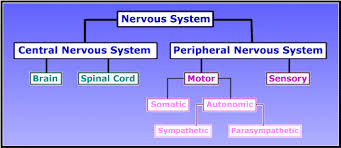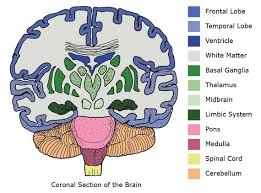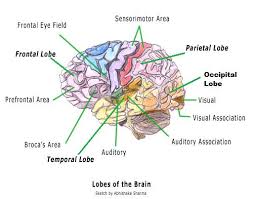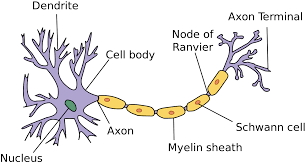Introduction to Neuroanatomy: Difference between revisions
No edit summary |
No edit summary |
||
| Line 61: | Line 61: | ||
The CNS is enclosed within the skull and vertebral column. These structures are separated by a series of membranes known as the Meninges. The '''Pia Mater''' is separated from the delicate '''arachnoid membrane''' by the '''subarachnoid space''', which is then in turn separated from the'''Dura mater '''by the '''Sub-dural space'''. | The CNS is enclosed within the skull and vertebral column. These structures are separated by a series of membranes known as the Meninges. The '''Pia Mater''' is separated from the delicate '''arachnoid membrane''' by the '''subarachnoid space''', which is then in turn separated from the'''Dura mater '''by the '''Sub-dural space'''. | ||
== Neurons == | == Neurons == | ||
*[[Image:Neuron.png|frame|right]]The ''' | *[[Image:Neuron.png|frame|right]]The C'''ell body''' contains the nucleus and surrounding cytoplasm. It is the focus of the cells metabolic processes, housing the mitochondria, golgi apparatus and peroxisomes. | ||
*The'''Dendrites''' are neuronal processes that taper from the cell body outwards. They produce many branches and transmit information towards the cell body from synapses on the dendritic tree. their primary role is to increase the surface area for synapse formation, allowing a great number of synapses to integrate together. | *The '''Dendrites''' are neuronal processes that taper from the cell body outwards. They produce many branches and transmit information towards the cell body from synapses on the dendritic tree. their primary role is to increase the surface area for synapse formation, allowing a great number of synapses to integrate together. | ||
* | *There is only one '''Axon''' per neuron. originates at the axon hillock conducting information away from the cell body towards the nerve terminal and synapses. It can however, branch to produce several processes. The initial segment of the axon, as it emerges from the cell body, is the most excitable part of the neuron because it has a high density of sodium channels at this point. Therefore, it is at this point that the action potential is generated. | ||
*A Lipid bilayer ('''cell''' '''membrane''') encloses the neuron. It is within this that proteins are located. Some of these form ion channels, others form receptors to certain chemicals that are released by neurons. Others act as ion pumps, moving ions across the membrane. e.g Na+ - K+ exchange pump. | |||
*The Axolemma is the axonal surface membrane. | |||
== Sub Heading 3 == | == Sub Heading 3 == | ||
Revision as of 17:18, 22 February 2016
Original Editor - Your name will be added here if you created the original content for this page.
Top Contributors - Joanne Garvey, Lucinda hampton, Naomi O'Reilly, Laura Ritchie, Kim Jackson, Rachael Lowe, Kate Sampson, Admin, Tarina van der Stockt, Adam Vallely Farrell, Rucha Gadgil, Rewan Elsayed Elkanafany, Jess Bell, WikiSysop, Simisola Ajeyalemi, Mande Jooste, Scott Buxton and George Prudden
Overview of the Nervous System[edit | edit source]
The nervous system can be divided into 3 significant parts.
These are
- Autonomic Nervous System (ANS)
- Peripheral Nervous System (PNS)
- Central Nervous System (CNS)
1. Autonomic Nervous System
The ANS's main role is to innervate the internal and glandular organs. The peripheral component is defined in terms of the enteric, sympathetic, and parasympathetic systems. Efferent fibres of the ANS originate from the intermediate zone (lateral column) of the spinal cord or specific cranial nerve. and sacral nuclei, and synapse in a ganglion. These are are different for sympathetic or parasympathetic systems. Afferent fibres from the organs innervated by the ANS travel via the dorsal root to the spinal cord.
2. Peripheral Nervous System
The PNS consists of nerve trunks that are formed from both afferent axons which conduct sensory information to the spinal cord, and efferent fibres which transmit impulses primarily to muscles. If these a particular nerve is damaged, then there is resulting weakness to the muscle it supplies as well as sensory loss from the region it conveys information from.
The peripheral nerves connect with the spinal cord through foramina in the vertebra of the spine, or with the brain through foramina in the skull.
3. Central Nervous System
The CNS consists of the spinal cord and brain. The spinal cord connect to the brain via the brainstem which is situated at the base of the brain. This is composed of the medulla, pons, and mid-brain. It is in the brainstem that discrete collections of nuclei are situated for the formation of 10 of the 12 cranial nerves. The brainstem and the cerebellum
Cerebral Hemispheres of the Brain The cerebral hemispheres are composed of 4 major lobes
- Occipital
- Parietal
- Temporal (medial part of which are a series of structures including the Hippocampus)
- Frontal
The outer layer of the cerebral hemisphere is termed the cerebral cortex. This is inter-connected via pathways that run sub-cortically. It is these connections as well as the connections from the cerebral cortex to the brainstem, spinal cord and nuclei deep within the cerebral hemisphere that form the white matter of the cerebral hemishere.
The deep nuclei include structures such as thebasal ganglia and the thalamus.
Meninges
The CNS is enclosed within the skull and vertebral column. These structures are separated by a series of membranes known as the Meninges. The Pia Mater is separated from the delicate arachnoid membrane by the subarachnoid space, which is then in turn separated from theDura mater by the Sub-dural space.
Neurons[edit | edit source]
- The Cell body contains the nucleus and surrounding cytoplasm. It is the focus of the cells metabolic processes, housing the mitochondria, golgi apparatus and peroxisomes.
- The Dendrites are neuronal processes that taper from the cell body outwards. They produce many branches and transmit information towards the cell body from synapses on the dendritic tree. their primary role is to increase the surface area for synapse formation, allowing a great number of synapses to integrate together.
- There is only one Axon per neuron. originates at the axon hillock conducting information away from the cell body towards the nerve terminal and synapses. It can however, branch to produce several processes. The initial segment of the axon, as it emerges from the cell body, is the most excitable part of the neuron because it has a high density of sodium channels at this point. Therefore, it is at this point that the action potential is generated.
- A Lipid bilayer (cell membrane) encloses the neuron. It is within this that proteins are located. Some of these form ion channels, others form receptors to certain chemicals that are released by neurons. Others act as ion pumps, moving ions across the membrane. e.g Na+ - K+ exchange pump.
- The Axolemma is the axonal surface membrane.
Sub Heading 3[edit | edit source]
Recent Related Research (from Pubmed)[edit | edit source]
Extension:RSS -- Error: Not a valid URL: Feed goes here!!|charset=UTF-8|short|max=10
References[edit | edit source]
References will automatically be added here, see adding references tutorial.










